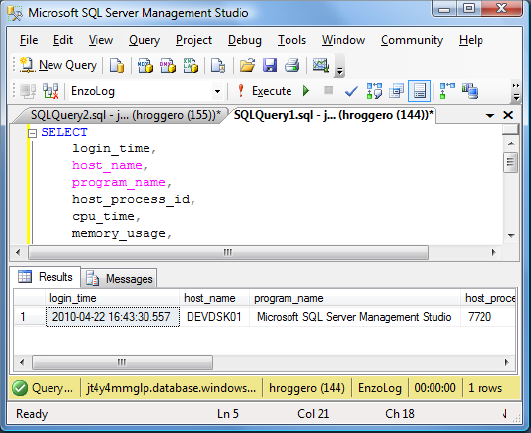Let's dive into the specifics of performance tuning,
keeping in mind what you've learned so far. You start by looking at
database tuning capabilities and then move up the stack, all the way to
the client library making the actual SQL call.
1. Dynamic Management Views
SQL Azure provides a few handy
system views called dynamic management views (DMVs) that are also
available in SQL Server. SQL Azure exposes a subset of the DMVs, but all
those related to query execution are available. SQL Azure supports the
DMVs listed in Table 1.
Table 1. Dynamic management views used for performance tuning
| DMV | Comments |
|---|
| sys.dm_exec_connections | Returns
the list of connections established in SQL Azure. Note that some of the
interesting columns, such as client_net_address (returning the client
machine's MAC address), aren't available. |
| sys.dm_exec_query_plan | Fully supported. Returns the XML execution plan of a SQL query or a batch. |
| sys.dm_exec_query_stats | Fully supported. Returns aggregate performance information for cached query plans. |
| sys.dm_exec_requests | Fully supported. Returns information about the statements being executed by SQL Azure. |
| sys.dm_exec_sessions | Partially
supported. Returns the current session opened along with performance
information about that session. However, it doesn't return last-login
information, such as the last_successful_logon column. |
| sys.dm_exec_sql_text | Returns the text of a SQL batch. |
| sys.dm_exec_text_query_plan | Returns the execution plan in text format for a SQL query or batch. |
NOTE
Although queries against
some of these views can run when you're connected to the master
database, they don't return the information you're looking for unless
you connect to the database that your application is running against.
Also, a user must have VIEW DATABASE STATE permission to see all
executing sessions on the database; otherwise, the user sees only the
current session.
If you're looking for
performance metrics for a SQL statement and you can isolate the
statement to a unique database connection, or the statement is no longer
executing, the dm_exec_sessions DMV is for you. This is one of the
system views that provides performance metrics such as CPU time and
duration. However, this DMV accumulates the performance metrics over all
the statements executed through the same connection. So, in order to
test a database query and retrieve performance metrics of that query
alone, you need to establish two connections: one to execute the query,
and another to read the performance metrics so as not to interfere with
the performance data that SQL Azure has collected.
NOTE
You need to establish
two connections using the same login name, or you can't retrieve the
performance metrics of the SQL statement you're trying to tune.
For example, establish a connection to SQL Azure, and run the following SQL query:
SELECT TOP 50 * FROM sys.indexes
Note your session id; it's found
on the status bar in Microsoft SQL Server Management Studio. You can
also find it on the query tab, in parentheses. For example, in Figure 1, the session id is 144: you can see it both on the selected tab and in the status bar at the bottom.

Next, open another query window, which opens a new connection in SQL Azure. Run the following query (see Figure 12-1), and make sure to specify the session id being investigated:
SELECT
login_time,
host_name,
program_name,
host_process_id,
cpu_time,
memory_usage,
total_elapsed_time,
reads,
writes,
logical_reads,
row_count,
original_login_name
FROM sys.dm_exec_sessions
WHERE session_id = 176 // replace with your session_id
This statement returns important performance metrics for your previous SQL statement, as explained in Table 2.
Table 2. Selected columns from sys.dm_exec_sessions
| Metric | Value | Comment |
|---|
| login_time | 2010-04-22 16:43:30.557 | The
login time of the session. Note that sessions can be reused over time,
through connection pooling. This time represents the last successful
login. |
| host_name | DEVDSK01 | The machine name that made the connection to the SQL Azure database. |
| program_name | SSMS | The application name that is executing the statement on the client workstation. |
| host_process_id | 7720 | The
Windows Process ID (PID) that is executing the statement on the client
workstation. You can view the PID of your applications in Task Manager
in Windows. |
| cpu_time | 15 | The CPU time, in milliseconds, consumed by the SQL statements since the connection was established. |
| memory_usage | 2 | Number of 8KB bytes consumed by the connection so far. |
| total_elapsed_time | 32 | The
duration of the statement in milliseconds. This includes the time to
execute the statement and the time it takes to return the data to the
client machine. |
| reads | 1 | Number of physical reads. |
| writes | 1 | Number of physical writes. |
| logical_reads | 322 | Number of logical reads. |
| row_count | 50 | Number of rows returned. |
| original_login_name | MyTestLogin | The login name of the user who successfully connected. |
At this point, you need to be
aware of a point that is very important for performance tuning. The
cpu_time is perhaps the best metric you can use to determine how long a
statement takes to execute in SQL Azure. The total_elapsed_time can be
misleading. Elapsed time represents the time it takes for SQL Azure (or
SQL Server) to fetch the data and return all the data to the client. So,
if your client is slow at displaying data, SQL Azure slows down to
match the speed of the client; the slowdown is a function of TCP
(Transmission Control Protocol) programming and has nothing to do with
SQL Azure. As a result, total_elapsed_time shows the entire time it
takes to execute the statement and the client time necessary to finish
fetching the data. The total_elapsed_time is the same than the Duration
measure returned by SQL Profiler.